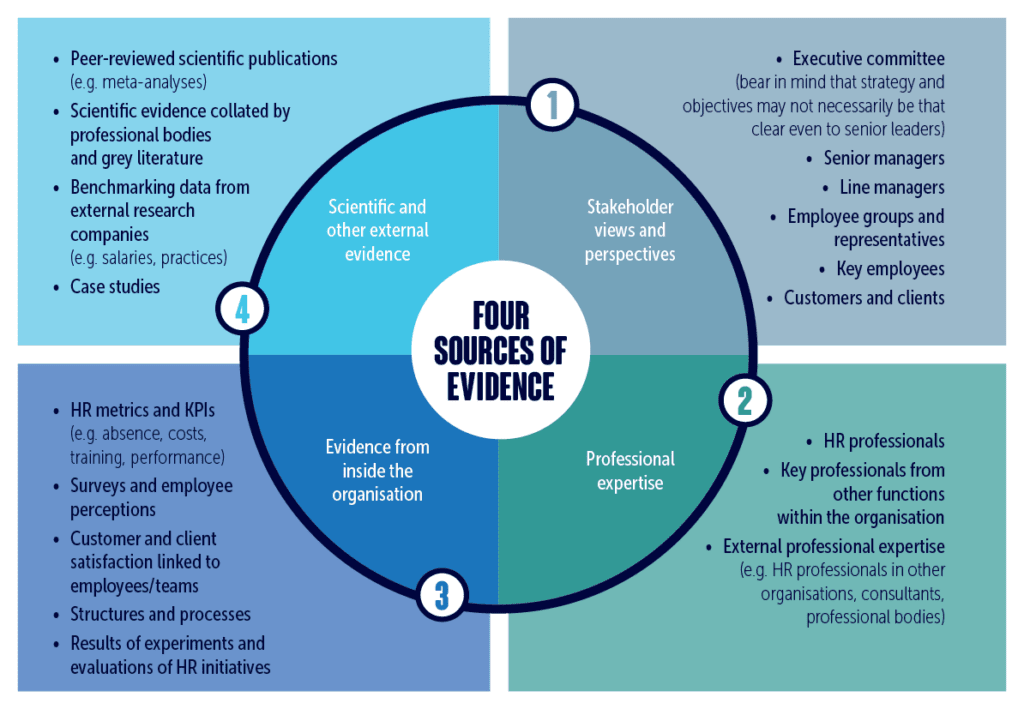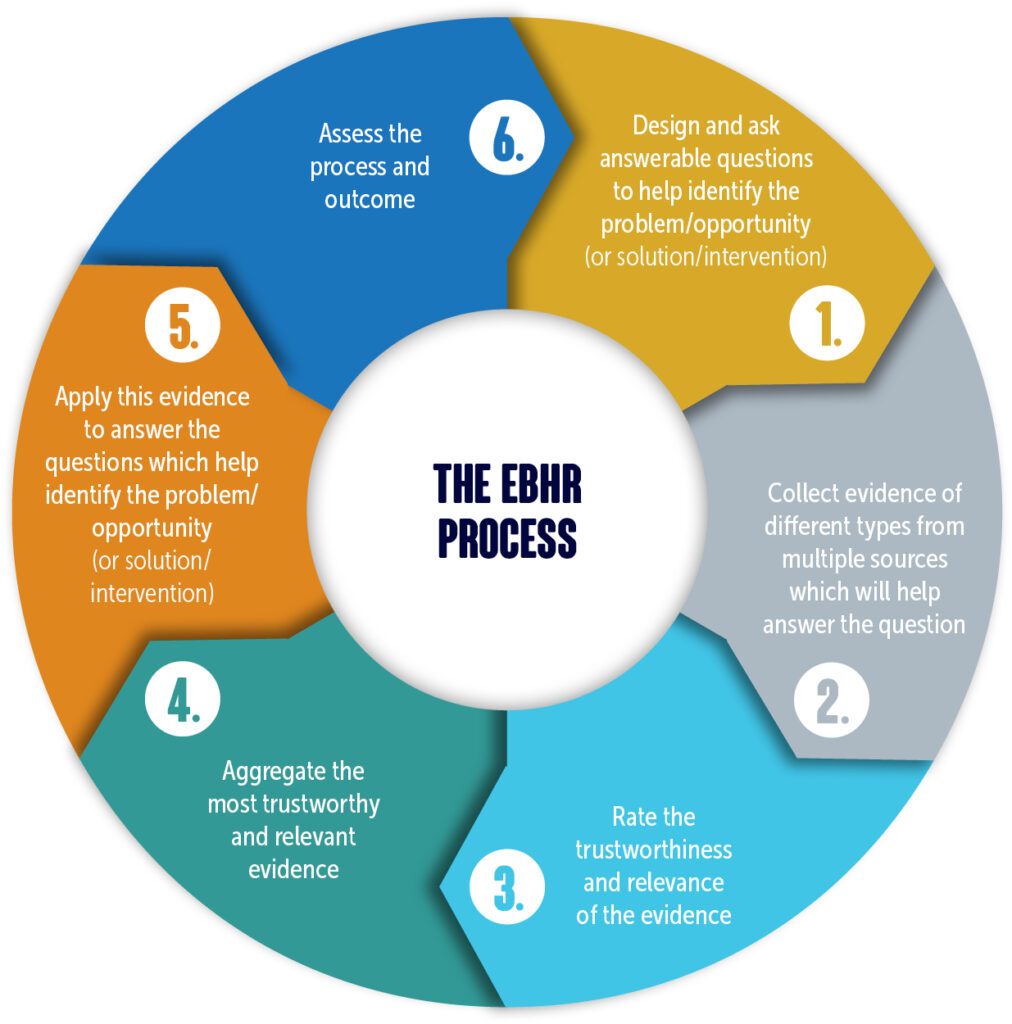Analytics and EBHR
Three New Year’s Resolutions for HR
Rob Briner, Associate Director of Research, Corporate Research Forum
Professor of Organizational Psychology, Queen Mary University of London
You’d be hard-pushed to find a single HR professional who thought HR’s use of data and evidence was perfect and simply could not be improved in any way.
There is now widespread acceptance – right across the profession – that more can and needs to be done to improve our use of evidence in order to improve our effectiveness as a function and add greater value to the business.
HR’s attitude towards evidence has changed
For me, this general shift in thinking towards making better-informed decisions is one of the most important changes in the profession over the past few decades.
When I first started writing and talking about Evidence-Based HR (EBHR) over 20 years ago I sensed more than a degree of defensiveness. Some practitioners seemed to feel that suggesting HR could do better when it came to evidence-based decisions was just another attack on the profession and therefore best ignored. Now, in contrast, it feels like I’m pushing at an open door when I make the same points.
But, it’s one thing to acknowledge that we should try improve the way we do something and quite another to actually do it.
What do EBHR and New Year’s resolutions have in common?
Trying to do more EBHR has much in common with classic New Year’s resolutions such as doing more exercise, losing weight or starting new hobbies. These are good things to try to accomplish. They seem relatively straightforward. It’s seems obvious what we need to do to make them happen. Yet, give it a year, and for most of us they just won’t have happened much, if at all.
These are all examples, like EBHR, of something that is highly desirable, not particularly complicated, but very hard to accomplish.
What makes EBHR difficult (though not complicated) to do and how can we make it easier?
One of the main reasons why EBHR is difficult is that within the HR profession we are just not used to making structured decisions following an explicit process of gathering and using evidence. Decisions somehow just get made. Data and evidence play a role in a somewhat haphazard way.
Adopting the EBHR model which describes the process we should ideally follow along with the four sources of evidence we can draw on, can seem too much. Particularly when we compare it to what we usually do.
It’s a bit like trying to follow a highly demanding exercise plan when we haven’t done any exercise for years. Or sticking to an all-encompassing and overwhelming diet regime when we’re used to eating whatever we want, whenever we like.
This is why breaking down broad yet desirable goals into more achievable smaller behaviours is more likely to bring about the results we want.
But can we do the same for EBHR?
Can starting to do EBHR be made easier?
One way of thinking about doing EBHR is to consider its basic principles. It’s important to remember that evidence-based practice has been around for at least 30 years. These principles have evolved over time – not to help people get fitter or eat better – but to help professionals make better-informed decisions.
In our recent report, Strong Foundations: Evidence-Based HR, we define EBHR as:
“…a process which delivers better-informed and hence more accurate answers to two fundamental questions: first, which are the most important problems (or opportunities) facing the organisation which are relevant to HR activities? Second, which solutions (or interventions) are most likely to help? In other words, what’s going on and what can we do about it? These questions are answered through a combination of using the best available evidence and critical thinking.”
What are the underlying principles of EBHR and how can we start to apply them in our work?
EBHR New Year Resolution 1:
Incorporate multiple sources and types of evidence and information.
Using multiple sources and types of evidence helps us to build a more complete and accurate picture of what’s happening and what we can do about it. In EBHR we typically consider four sources of evidence, each of which includes data of quite different types.

Do we always need to use all four sources? No. But using more sources is generally better. So, if you mostly rely on one or two sources or types of evidence when making decisions, next time consider drawing on more sources and using more types.
EBHR New Year Resolution 2:
Adopt a structured and explicit process of gathering and using evidence.
There are two aspects of this structure. The first entails understanding the issue before identifying a solution. The second is about taking a structured approach to collecting the evidence we need to answer our questions.

A structured and explicit process helps us to stay on track and ensure we are systematic in gathering and applying the evidence to help us make a better-informed decision. Do you have to follow every step of this process? Not necessarily, but trying to explicitly follow the process and being aware of which steps you’re skipping is likely increase your awareness of what you know – and don’t know – and the basis on which you have identified the issue and potential intervention.
Just using one part of this process – spending much more time really trying to understand the business issue before you think about a solution – will mean you are much more likely to understand the issue and choose a solution that will help.
EBHR New Year Resolution 3:
Focus on the most trustworthy and relevant evidence.
It seems that sometimes people think that EBHR is about gathering and using all the evidence we can get hold of. The problem is that much of the evidence around us is unreliable and irrelevant so we should not use it.
This means we should pay more attention to evidence that is more trustworthy and relevant and less attention to – or even ignore – evidence that is less trustworthy and relevant.
There are many simple ways of identifying the better-quality evidence. One is to ask questions such as: Do you personally trust or believe it or not – and why? What do your colleagues think? Are there reasons to think the data may be biased or have important omissions? Are you clear about how the evidence has been collected and is being presented?
Committing and sticking to EBHR resolutions
As said at the start, you’d be hard-pushed to find a single HR professional who thought HR’s use of data and evidence was perfect and simply could not be improved in any way. Almost all of us feel we can and should do better. But how?
One way of doing this is to commit to at least trying to do more EBHR in 2024 through making and sticking to the three EBHR New Year Resolutions. At the same time, it’s essential to remember that EBHR is not about making perfect decisions but better-informed decisions. And that’s a goal that’s desirable and achievable for us all.
Find out more about CRF’s research Evidence-Based HR: A New Paradigm, including how to sign up to our events on 25 January and 7 February, here.
UPCOMING EVENT
Evidence-Based HR:
A New Paradigm
25 January, In-Person, London
7 February, Online

